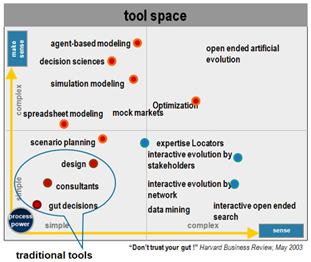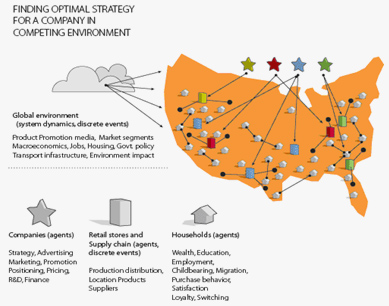 Every strategic decision is based on a model. Whether they are on our minds or on computers, models are the platforms we make decisions. They are based on how we see the world, how we deduce results from our business. The better models represent the real world and the technologies enable to implement these models, the sounder the business decisions become. Every strategic decision is based on a model. Whether they are on our minds or on computers, models are the platforms we make decisions. They are based on how we see the world, how we deduce results from our business. The better models represent the real world and the technologies enable to implement these models, the sounder the business decisions become.
Therefore technologies supporting strategic decisions should be able to deal with the facts that today’s world is highly dynamic, uncertain, involves endless interrelations that are hard to manage and includes ever increasing options with different outcomes. This environment necessitates new generation “sense” and “make sense” technologies with matching capabilities. (The graph extracts some of the developments in this context, Harvard Business Review, May 2003 issue).
Models and modeling technologies should portray the following facts:
- Events are the results of its whole ecosystem’s dynamics. They happen as the outcome of the system’s structure and the non-linear relationships among all the parts. Understanding these relationships and consequences as a whole should be the aim of the models. Trying to do foresight by the help of ongoing reports, trend analysis, statistical analysis or linear models decrease our ability to see the big picture and can become dangerous to apply.
 What makes business ecosystems complex is the people factor. Human behavior does not directly accept most corporate policiesbut send feed back in some form and create unexpected results. Due to this fact, all major players (competitors, customers, employees etc.) in a business and their decision making processes should be modeled and become a part of corporate strategic analysis. What makes business ecosystems complex is the people factor. Human behavior does not directly accept most corporate policiesbut send feed back in some form and create unexpected results. Due to this fact, all major players (competitors, customers, employees etc.) in a business and their decision making processes should be modeled and become a part of corporate strategic analysis.
- Strategy is as much related to managing soft factors (loyalty, skill level, knowledge etc) as financial variables. These intangible factors should be mathematically modeled and tied to our strategic decision making.
- By definition, strategy is about the future. It requires a special design for foresight capabilities as the primary objective.
As the business game gets more complex and the strategic options ahead of us increase, companies should use tools with high processing capabilities like dynamic simulations, agent based models, scenario management and non-linear optimization. |